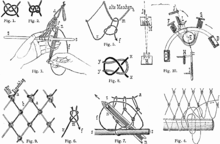Fishing net


A fishing net is a close-meshed, net-like textile fabric that is used for fishing . The net consists of the " knotting of a row of threads with a thread sequence" and "has the greatest immovability because the [...] knots close more tightly when pulled in each of the thread directions."
history
Fishing nets and ropes made from willow bast have been proven as early as the Mesolithic . Names for certain types of fishing nets are also tragŭla (covered with cork, which was pulled through the water), thread sack or thread tube (tubular fishing net, which at the mouth consists of two walls and is very wide, closed at the pointed end and 3–6 m long), raffle (consists of several round sacks, which are stretched out by traps and united with one another; wings are attached to the sides of these sacks. The net is fastened with stakes in the water and only removed after a day or two) and tsars ( bag-shaped fishing net attached to a long hoop at the top and bottom).
In ancient Egypt , fishing with a trawl or traction net was part of the image program in private tombs since the Old Kingdom . Illustrations show that the mesh was created by braiding or knotting flax threads.
In Egyptian mythology , too , the net played a decisive role in the belief in the afterlife, since the soul of the dead in the form of a migratory bird or fish could be in danger of getting caught in the safety net during the transition to the afterlife and thus be completely wiped out. Defense statements in the coffin texts and in the book of the dead prove that the dead could defend themselves against this by knowing the individual parts of the net.
In a figurative sense, the net in the Bible - Peter the Fisherman - served as a symbol for the "gathering" of people into the Christian context of faith; The (fishing) net is also used in gladiator fights, on the occasion of which the fighter, also equipped with a trident, should immobilize the opponent with his net.
In the course of the global increase in net fishing , torn nets pollute the seas and oceans with up to 10% of the total amount of waste. In Chile , as a result of recycling projects , they are processed into plastic granulate and later into skateboards and sunglasses .
species

A distinction is made depending on the type of network and the type of its respective use:
- Tree trawler
- Ground network
- Hamen
- Gill net
- Purse seine
- Trawl
- Submerged network
- Gillnet
- Drift net
- Throw net
Mesh size
The mesh size is tailored to the fish to be caught. Certain minimum mesh sizes are required to ensure that fewer fry are caught. These are agreed in international agreements and are mutually controlled (see fishing ).
The term mesh size (formerly also called light ) is often mistakenly confused with the term mesh size . A mesh size is just a length between two adjacent knots (see DIN 61250 terms, netting).
Knotting technique
When knotting, hundreds of knots are strung together with a net needle . The Schotstek is used .
Industrial fishing nets are cut from industrially manufactured netting and sewn together to match by hand. The net needle is used for this.
A trawl net can be sewn at the end with a loop seam which, after hauling in the net - for example on board a fishing vessel - is opened by simply pulling the end of the rope to let the catch flow out. A loop seam can be sewn with a crochet hook or purely by hand without a net needle.
See also
Web links
Individual evidence
- ↑ fishing net . In: Brockhaus' Kleines Konversations-Lexikon . 5th edition. Volume 1, F. A. Brockhaus, Leipzig 1911, p. 584 .
- ↑ Almut Bick: The Stone Age . Theiss WissenKompakt, Stuttgart 2006. ISBN 3-8062-1996-6
- ↑ Tragŭla 2). In: Heinrich August Pierer , Julius Löbe (Hrsg.): Universal Lexicon of the Present and the Past . 4th edition. tape 17 . Altenburg 1863, p. 748 ( zeno.org ).
- ↑ Garnsack 1). In: Heinrich August Pierer , Julius Löbe (Hrsg.): Universal Lexicon of the Present and the Past . 4th edition. tape 6 . Altenburg 1858, p. 932 ( zeno.org ).
- ↑ Raffle . In: Heinrich August Pierer , Julius Löbe (Hrsg.): Universal Lexicon of the Present and the Past . 4th edition. tape 13 . Altenburg 1861, p. 796 ( zeno.org ).
- ↑ Tsar . In: Heinrich August Pierer , Julius Löbe (Hrsg.): Universal Lexicon of the Present and the Past . 4th edition. tape 19 . Altenburg 1865, p. 525 ( zeno.org ).
- ↑ Waltraut Guglielmi, in: Lexikon der Ägyptologie Volume IV , keyword Netz , Otto Harrassowitz Wiesbaden 1982, p. 464.
- ↑ Waltraut Guglielmi, in: Lexikon der Ägyptologie Volume IV , keyword Netz , Otto Harrassowitz Wiesbaden 1982, p. 465.
- ↑ ARD ( Memento of the original from November 4, 2016 in the Internet Archive ) Info: The archive link was inserted automatically and has not yet been checked. Please check the original and archive link according to the instructions and then remove this notice. Tudo Bem from November 1, 2016, 10:08 a.m., 6 min, accessed on November 3, 2016
- ^ Heinrich Grimm: New contributions to the "fish literature" of the XV. to XVII. Century and through their printer and bookkeeper. In: Börsenblatt for the German book trade - Frankfurt edition. No. 89, November 5, 1968 (= Archive for the History of Books. Volume 62), pp. 2871–2887, here: p. 2878.
- ↑ Die Sendung mit der Maus - Fischernetz BR-Alpha, dailymotion.com, published September 6, 2015, accessed July 22, 2019. Video (7:51) - Production of a net at manufacturer Rofia, model and underwater images.

